Complete Solutions to SECTION-II of chapter BIOLOGY-2019 of Class 10 book with complete answers and questions
| Class 10 | BIOLOGY |
| Chapter | BIOLOGY-2019 |
| GURUKUL PUBLICATION | SECTION-II |
| Number Of Questions | 60 |
| Academic Year | 2023-24 |
Given below is an experimental setup to demonstrate a particular tropic movement in germinating seeds. Study the diagram and answer the questions that follow :

Label the parts 1 and 2.
View SolutionGiven below is an experimental setup to demonstrate a particular tropic movement in germinating seeds. Study the diagram and answer the questions that follow :

Name the tropic movement shown by part 1.
View SolutionGiven below is an experimental setup to demonstrate a particular tropic movement in germinating seeds. Study the diagram and answer the questions that follow :

Part 1 is affected by two stimuli. Name them. Which one of the two is stronger
View SolutionGiven below is an experimental setup to demonstrate a particular tropic movement in germinating seeds. Study the diagram and answer the questions that follow :

What is Thigmotropism 2 Give one example,
View SolutionGiven below is an experimental setup to demonstrate a particular tropic movement in germinating seeds. Study the diagram and answer the questions that follow :

What is meant by Positive and negative tropic movements in plants
View SolutionGive the exact location and one function of the following:
Testis
View SolutionMention the exact location of the following :
Incus
View SolutionMention the exact location of the following structures : Thylakoids.
View SolutionMention the exact location of the Amniotic fluid
View SolutionState the exact location of the following:
Corpus callosum
View SolutionThe diagram given below represents an experiment to prove the importance of a factor in photosynthesis. Answer the questions that follow

Name the factor studied in this experiment
View SolutionThe diagram given below represents an experiment to prove the importance of a factor in photosynthesis. Answer the questions that follow

What will you observe in the experimental What will you observe in the experimental
View SolutionThe diagram given below represents an experiment to prove the importance of a factor in photosynthesis. Answer the questions that follow

Explain the process of Photosynthesis
View SolutionThe diagram given below represents an experiment to prove the importance of a factor in photosynthesis. Answer the questions that follow

Explain the process of Photosynthesis
View SolutionThe diagram given below represents an experiment to prove the importance of a factor in photosynthesis. Answer the questions that follow
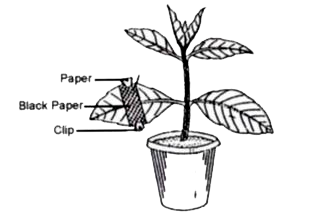
Draw a neat, labelled diagram of an experimental setup to show that oxygen is released during photosynthesis
View SolutionMain function of enterokinase is:
View SolutionState the main functions of the following: Cytokinins
View SolutionState the main functions of the following:
Tears
View SolutionState main functions of :
Coronary artery
View SolutionGiven below is the outline of the cross-section of the male reproductive system :

(i) Copy the outline on to your answer sheet with pencil and label the following parts testis, epididymis, seminal vesicles, vas deferens
(ii) Name the hormone produced by the testis.
(iii) Why are sperms produced in large numbers?
(iv) State the function of the seminal vesicles.
View SolutionThe diagram given below represents an organ system in the human body. Study the same and answer the questions that follow:

Identify the system.
View SolutionThe diagram given below represents an organ system in the human body. Study the same and answer the questions that follow:

Label the parts marked 2 and 4. Mention the function of part 5.
View SolutionThe diagram given below represents an organ system in the human body. Study the same and answer the questions that follow:
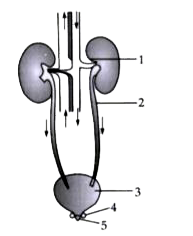
Name the structural and functional units of the part marked 1.
View SolutionThe diagram given below represents an organ system in the human body. Study the same and answer the questions that follow:

What is the fluid that accumulats in part 3?
Which is the main nitrogenous waste present in it?
View SolutionThe diagram given below represents an organ system in the human body. Study the same and answer the questions that follow:
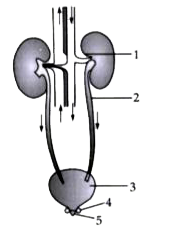
Draw a neat, labelled diagram showing the longitudinal section of part 1.
View SolutionThe diagram given below represents an endocrine gland in the human body. Study the diagram and answer the following questions :

(i) Identify the endocrine gland. Where is it located?
(ii) Why is the above gland referred to as the 'Master gland' ?
(iii) Name the hormone which in deficiency causes Diabetes Insipidus. How does this disorder differ from Diabetes Mellitus ?
(iv) Explain the term 'Hormone'.
What is the role of Tropic hormones in the human body?
(v) Which lobe of the above gland secretes:
1. Oxytocin
2. ACTH
3. Growth hormone.
View SolutionThe diagram given below represents an endocrine gland in the human body. Study the diagram and answer the following questions :

(i) Identify the endocrine gland. Where is it located?
(ii) Why is the above gland referred to as the 'Master gland' ?
(iii) Name the hormone which in deficiency causes Diabetes Insipidus. How does this disorder differ from Diabetes Mellitus ?
(iv) Explain the term 'Hormone'.
What is the role of Tropic hormones in the human body?
(v) Which lobe of the above gland secretes:
1. Oxytocin
2. ACTH
3. Growth hormone.
View SolutionThe diagram given below represents an endocrine gland in the Human body.

Name the hormone which is deficiency causes Diabetes Insipidus.
How does this disorder differ from Diabetes Mellitus?
View SolutionThe diagram given below represent an endocrine gland in the human body. Study the diagram and answer the question :

Explain the term .Hormone.. What is the role of Tropic hormones in the human body?
View SolutionThe diagram given below represent an endocrine gland in the human body. Study the diagram and answer the question :

Which lobe of the above gland secretes : 1. Oxytocin 2. ACTH 3. Growth hormone
View SolutionGiven below is an apparatus which was setup to investigate a physiological process in plants. The setup was placed in bright sunlight. Answer the questions that follow:
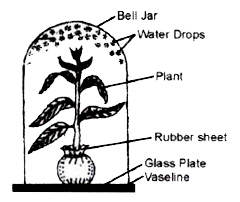
Name the process being studied. Define the process.
View SolutionGiven below is an apparatus which was setup to investigate a physiological process in plants. The setup was placed in bright sunlight. Answer the questions that follow:

Why was the pot enclosed in a rubber sheet ?
View SolutionGiven below is an apparatus which was setup to investigate a physiological process in plants. The setup was placed in bright sunlight. Answer the questions that follow:

Mention two external factors which can accelerate the above process.
View SolutionGiven below is an apparatus which was setup to investigate a physiological process in plants. The setup was placed in bright sunlight. Answer the questions that follow:

List two adaptations in plants to reduce the above process.
View SolutionGiven below is an apparatus which was setup to investigate a physiological process in plants. The setup was placed in bright sunlight. Answer the questions that follow:

Draw a neat, labelled diagram of a stomata! apparatus.
View SolutionGiven below are two stages in the evolution of man. Study them and answer the questions that follow :

(i) Identify Australopithecus and Neanderthal man from the above pictures.
(ii) Mention two characteristic features each for the two stages.
(iii) Who proposed the theory of Natural Selection?
(iv) Name the organism used as an example to explain 'Industrial Melanisum'.
(v) Give two examples of Vestigial organs in humans.
View SolutionGiven below are two stages in the evolution of man. Study them and answer the questions that follow :

(i) Identify Australopithecus and Neanderthal man from the above pictures.
(ii) Mention two characteristic features each for the two stages.
(iii) Who proposed the theory of Natural Selection?
(iv) Name the organism used as an example to explain 'Industrial Melanisum'.
(v) Give two examples of Vestigial organs in humans.
View SolutionGiven below are two stages in the evolution of man. Study them and answer the questions that follow :

(i) Identify Australopithecus and Neanderthal man from the above pictures.
(ii) Mention two characteristic features each for the two stages.
(iii) Who proposed the theory of Natural Selection?
(iv) Name the organism used as an example to explain 'Industrial Melanisum'.
(v) Give two examples of Vestigial organs in humans.
View SolutionGiven below are two stages in the evolution of man. Study them and answer the questions that follow :

(i) Identify Australopithecus and Neanderthal man from the above pictures.
(ii) Mention two characteristic features each for the two stages.
(iii) Who proposed the theory of Natural Selection?
(iv) Name the organism used as an example to explain 'Industrial Melanisum'.
(v) Give two examples of Vestigial organs in humans.
View SolutionGiven below are two stages in the evolution of man. Study them and answer the questions that follow :

(i) Identify Australopithecus and Neanderthal man from the above pictures.
(ii) Mention two characteristic features each for the two stages.
(iii) Who proposed the theory of Natural Selection?
(iv) Name the organism used as an example to explain 'Industrial Melanisum'.
(v) Give two examples of Vestigial organs in humans.
View SolutionIn Mendel's experiments, tall pea plants (T) are dominant over dwarf pea plants (t).
What is the phenotype and genotype of the `F_1` generation if a homozygous tall plant is crossed with a homozygous dwarf plant ?
View SolutionIn Mendel's experiments, tall pea plants (T) are dominant over dwarf pea plants (t).
Draw a Punnett square board to show the gametes and offspring when both the parents are heterozygous for tallness.
View SolutionIn Mendel's experiments, tall pea plants (T) are dominant over dwarf pea plants (t).
What is the phenotypic ratio and genotypic ratio of the above cross in (ii) ?
View SolutionIn Mendel's experiments, tall pea plants (T) are dominant over dwarf pea plants (t).
State Mendel's Law of Dominance.
View SolutionIn Mendel's experiments, tall pea plants (T) are dominant over dwarf pea plants (t).
What is a Dihybrid Cross?
View SolutionGiven below is a diagram representing a stage during the mitotic cell division। Study the diagram and answer the following questions :

Identify the stage by giving a suitable reason.
View SolutionGiven below is a diagram representing a stage during the mitotic cell division। Study the diagram and answer the following questions :

Is it a plant or an animal cell? Give a reason to support your answer.
View SolutionGiven below is a diagram representing a stage during the mitotic cell division। Study the diagram and answer the following questions :
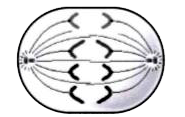
Draw a neat, labelled diagram of the stage which follows the one shown in the diagram.
View SolutionGiven below is a diagram representing a stage during the mitotic cell division। Study the diagram and answer the following questions :

How many chromosomes will each daughter cell have after the completion of the above division ?
View SolutionGiven below is a diagram representing a stage during the mitotic cell division। Study the diagram and answer the following questions :

Name the four nitrogenous bases.
View SolutionHow are the cytons and axons placed in the brain and the spinal cord ?
View SolutionWith reference to the human ear, answer the questions that follow :
Name the part of the ear associated with
(a) static balance (6) hearing (c) dynamic balance.
View SolutionAnswer the following questions briefly :
Explain how the human eye adapts itself to bright light and dim light.
View SolutionWhat is Parthenocarpy ? Give one example.
View SolutionMention any two objectives of 'Swachh Bharat Abhiyan'.
View SolutionThe diagram given belwo represents a system in the human body. Study the diagram and answer the following question:
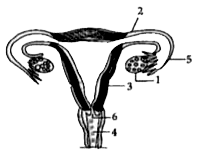
Identify the system.
View SolutionThe diagram given below represents a system in the human body. Study the diagram and answer the following question:

Label the parts marked 5 and 6.
View SolutionThe diagram given below represents a system in the human body. Study the diagram and answer the following question:

Name the two hormones secreted by 1.
View SolutionThe diagram given below represents a system in the human body. Study the diagram and answer the following question:

Mention the number and the name of the part involved in fertilization and implantation from the above diagram.
View SolutionThe diagram given below represents a system in the human body. Study the diagram and answer the following question:

Mention the surgical methods of contraception in
1. Human males
2. Human females.
View Solution
SECTION-II questions and complete solutions for chapter BIOLOGY-2019 of EVERGREEN BIOLOGY (ENGLISH) of Class 10